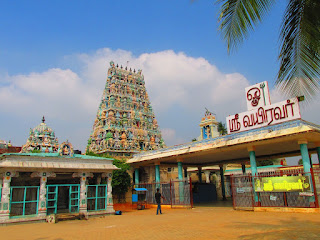Chettinad, comprising the present Sivaganga district and certain areas of Pudukkottai district in Tamil Nadu, India, is the cherished homeland of the Nattukkottai Chettiars, also known as the Nagarathars, a prosperous and esteemed business community in Tamil Nadu.
Within the vibrant tapestry of Chettinad, there are nine significant temples exclusively dedicated to the Nagarathars, aptly known as the Nagarathar Temples. Vairavan Temple, nestled in Vairavanpatti, stands as one of these esteemed nine temples. Situated approximately 15 kilometers from Karaikudi, locals affectionately refer to this village as Vairavan Kovil.

Highlights:
- This is one of the nine Nagarathar temples.
- This is one of the most popular Bhairava temples in Tamil Nadu.
- God - Valaroli Nathar and Bhairava
- Goddess - Vadivudai Nayaki
- Teerth (Holy water) - Vairavan Teerth
- Sthala Vruksha (Holy tree) - Azhinji
- The village was also called as Veera Pandiapuram, Vayiramapuram and Vaduganathapuram in the olden days.
 Legend:
Legend:
Legend has it that the Devas, vexed by the Asura brothers Surapadma, Simhamukha, and Taraka, sought refuge in Lord Shiva. The compassionate Lord Shiva assumed the form of a Brahmin and guided the Devas to worship a Shiv Linga at this very site. Following these divine instructions, the Devas fervently worshiped Valorali Nathar and found solace and courage to confront the Asuras.
 History:
History:
In terms of historical origins, the temple authorities assert that Nagarathars constructed this temple in 712 CE. However, there is a lack of concrete historical evidence supporting this date, such as stone inscriptions. Moreover, the existing temple structure, including the tower, vimanas, stucco images, and sculptures, appears to be relatively recent, likely dating back only a little over 200 years. It unmistakably reflects the distinctive Nagarathar architectural style. The possibility exists that this temple might have undergone renovation or reconstruction by the Nagarathars on the site of an earlier temple structure.
Temple Layout, Architecture and Sculptures:
Exterior:
The east-facing temple tower (gopuram), rising five tiers high, boasts a plethora of captivating stucco images. Among these, one of the most captivating is a rare depiction of Subramanya with twelve heads and twenty-four arms.
The temple complex features the Vayiravar Teertham pond located prominently in front.
Additionally, the shrine of Ganesha and Muppali Karuppar can be found outside the tower. Karuppar, a village deity and the temple's guardian deity, is traditionally restricted to male devotees.
Main Shrines:
The east-facing sanctum is home to a grand Shiv Linga known as Valorli Nathar, while the goddess Vadivudai Nayaki occupies a separate south-facing shrine.
An intriguing facet is the south-facing shrine of Bhairava, situated between Valorli Nathar and Vadivudai shrines. Although the temple's presiding deity is Valorli Nathar, Bhairava enjoys greater popularity, and the temple is often colloquially referred to as the Vayiravan (Bhairava) Temple.
Within the shrine of Bhairava, there is a stone icon of a girl named Valli Ammai, a devoted Nagarathar, who lived her entire life in unwavering devotion to Bhairava. Similar to Andal, her profound devotion has elevated her to the status of a deity.
The gigantic icon of Bhairava is found in his usual standing posture and his vahana, dog. He has four arms and looks fierce. He is seen standing on a lotus pedestal.
 Mandapas:
Mandapas:
The temple, encompassing a vast expanse, boasts numerous mandapas and sub-shrines. The pillars within the Maha Mandapa feature an array of intriguing sculptures, including Bhikshatana, Gandharvas, the divine union of Meenakshi and Sundareswara, Subramanya seated gracefully on a peacock, Shankara Narayana, Narasimha subduing Hiranya, Rishabharuda Murti, Nardana Ganapati, and many more.
The Mukha Mandapa supplements this artistic narrative with additional pillar sculptures, including Rati, Manmatha, Kodanda Rama, Lakshmana, Sita, the Hunter and his wife, Bhairava, Aghora Bhadra, Veera Bhadra, Urdhava Tandava Moorti, and the dancing Kali, among others.

The temple is adorned with an array of deities and sub-shrines, featuring Nataraja, Ganesha, Murugan, Surya, Chandra, Vishwanatha-Vishalakshi, Kanni Moola Ganapati, Subramanya accompanied by his consorts on his trusty peacock, Navagraha, Chandikeshwara, Adi Vadivudai Amman, and Saraswati.
The Koshta deities comprise Brahma, Lingodbhava, and Dakshinamurti. Notably, the Dakshinamurti mandapa houses two musical pillars.
Intriguingly, the temple prakara features a unique sculpture of Lord Rama standing with folded hands before Hanuman.
On the temple's walls and ceiling, visitors can marvel at a multitude of captivating mural paintings.
The list of nine Nagarathar temples is given below:
1) Illayathangudi Kovil
2) Mathur Kovil
3) Vairavan Kovil
4) Iraniyur Kovil
5) Pillaiyarpatti
6) Nemam
7) Illuppaikudi Kovil
8) Sooraikudi Kovil
9) Velankudi Kovil
Happy travelling.












.JPG)
Comments
Post a Comment